 |
HMCS NIPIGON in April 1998, leaving Halifax Harbour for a small exercise.
The rounded surfaces characteristic of the Cadillacs can be seen to good
effect around the bow. |
 |
A shot taken broadside of the bridge area. The FMC dual 3"/50 gun is
shown to the right, with the lattice mast to the left. The bridge crew
can be seen on the open bridge just in front of the fire control radar.
The legs of a jack-up oil rig can be seen in the background, behind George's
Island in Halifax Harbour. |
 |
The Cadillacs introduced a number of inovations, including one shown
here. Instead of installing all the anchor handling gear above decks as
on most ships, on the Cadillacs it was installed in a compartment below
decks under the forecastle. The anchor winch is shown here. |
 |
This shot was taken through the port side port on the 3"/50 gun, with
the spring that absorbs the port barrels recoil visible in the upper left
of the photo. |
 |
Looking from the bridge out over the gun shield on the 3"/50. |
 |
This picture looks to port from the starboard side of the interior
bridge. |
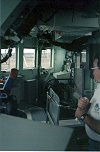 |
Looking to starboard in the interior bridge. |
 |
Another shot looking to starboard in the bridge. |
 |
The open bridge on NIPIGON. The engine and throttle indicators are
visible in the centre of the photo. |
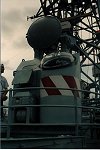 |
This is the manned fire control radar unit. It consists of a SPG 515
fire control radar mounted on a Mk.69 gunnery control system. It is manned
by two crewmembers. |
 |
Looking down at the open bridge from the Mk.69 platform. |
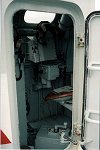 |
The starboard interior of the Mk.69 gunnery control system. The Mk.69
unit dates back to the late 1950's, but was only added to the ANNAPOLIS
class during refits in the early 1980's. |
 |
A close-up of the port side open bridge. |
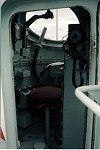 |
The port side of the Mk.69 gunnery control system. |
 |
The tail end of NIPIGON's quarterdeck. This area used to be dominated
by a Limbo mortar well and the deployment gear for the old VDS, but both
of these have been removed. |
 |
The transom of NIPIGON now sprorts three ports. The two on the left
are for the Nixie torpedo decoy, and the one in the middle is for the CANTASS
(CANadian Towed Array Sonar System), which is based on the USN's SQR 19,
but with new Canadian processors. |
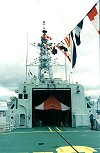 |
The helicopter deck and hangar. The track in the deck running into
the hangar is for the Beartrap helicopter haul-down system. |
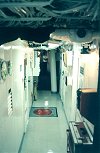 |
This passageway is at the base of the bridge superstructure on the
port side, looking aft. The ladder to the bridge is to the left of this
photo. |
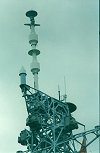 |
The top of NIPIGON's mast. |
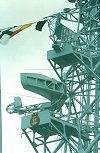 |
This is the forward end of the lattice mast. This mast replaced the
original mast during the mid-80s refit. The lower radar is the Marconi
SPS 503 air search radar, while the upper is the Raytheon SPS 502 surface
search radar. Note NIPIGON's badge on the platform for the SPS 503. |
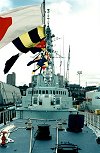 |
NIPIGON's forecastle taken looking aft towards the bridge. The 3"/50
gun is just in front of the bridge. The hatch on the port side (the right
of the photo) leads down to the anchor winch compartment. |
 |
The jackstaff is in the background of this shot looking forward on
the forecastle. |
 |
A view of NIPIGON from the aft starboard quarter. The starboard Mk.32
torpedo launcher can be seen under the hangar at deck level. |